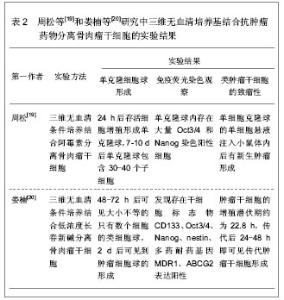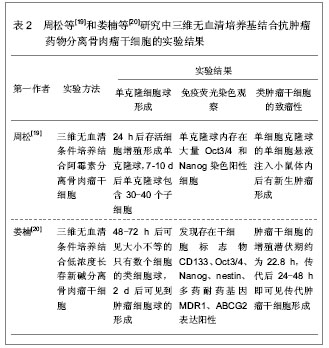| [1] Tang N, Song WX, Luo J, et al. Osteosarcoma development and stem cell differentiation. Clin Orthop Relat Res. 2008;466(9):2114-2130. [2] Lewis IJ, Nooij MA, Whelan J, et al. Improvement in histologic response but not survival in osteosarcoma patients treated with intensified chemotherapy: a randomized phase III trial of the European Osteosarcoma Intergroup. J Natl Cancer Inst. 2007;99(2):112-128.[3] Meyers PA, Schwartz CL, Krailo MD, et al. Osteosarcoma: the addition of muramyl tripeptide to chemotherapy improves overall survival--a report from the Children's Oncology Group. J Clin Oncol. 2008;26(4):633-638.[4] 李力韬,郭乔楠.骨肉瘤干细胞的研究现状与进展[J].西部医学,2012,24(5):1027-1029.[5] Kansara M, Thomas DM. Molecular pathogenesis of osteosarcoma. DNA Cell Biol. 2007;26(1):1-18.[6] 朱忠胜,张春林.骨肉瘤干细胞研究现状[J].国际骨科学杂志,2011,32(5):296-299.[7] Pittenger MF, Mackay AM, Beck SC, et al. Multilineage potential of adult human mesenchymal stem cells. Science. 1999;284(5411):143-147.[8] Wang L, Park P, Lin CY. Characterization of stem cell attributes in human osteosarcoma cell lines. Cancer Biol Ther. 2009;8(6):543-552.[9] Tirino V, Desiderio V, d'Aquino R, et al. Detection and characterization of CD133+ cancer stem cells in human solid tumours. PLoS One. 2008;3(10):e3469. [10] Gibbs CP, Kukekov VG, Reith JD, et al. Stem-like cells in bone sarcomas: implications for tumorigenesis. Neoplasia. 2005;7(11):967-976.[11] Lapidot T, Sirard C, Vormoor J, et al. A cell initiating human acute myeloid leukaemia after transplantation into SCID mice. Nature. 1994;367(6464):645-648.[12] Fujii H, Honoki K, Tsujiuchi T, et al. Sphere-forming stem-like cell populations with drug resistance in human sarcoma cell lines. Int J Oncol. 2009;34(5):1381-1386.[13] Wilson H, Huelsmeyer M, Chun R, et al. Isolation and characterisation of cancer stem cells from canine osteosarcoma. Vet J. 2008;175(1):69-75.[14] 中国知网.中国学术期刊总库[DB/OL].2013-1-12.https://www.cnki.net[15] 万方数据库.万方数据知识服务平台[DB/OL].2013-1-12.http://www.wanfangdata.com.cn/ [16] 欧阳振,王栓科,康学文,等.人骨肉瘤细胞株U2-OS中分离并鉴定肿瘤干细胞[J].中国组织工程研究与临床康复,2007,11(24): 4706-4709.[17] 韩兴文,王栓科,康学文,等.Nanog mRNA在骨肉瘤类肿瘤干细胞中的表达和意义[J].第四军医大学学报,2009,30(6):513-516.[18] 张培根,王栓科,康学文,等.赛来昔布对人骨肉瘤类肿瘤干细胞移植瘤微血管生成的影响[J].中国矫形外科杂志,2009,17(1): 59-62.[19] 周松,李锋,肖骏,等.三维无血清条件培养结合抗癌药物分离人骨肉瘤肿瘤干细胞[J].实用癌症杂志,2010,25(1):5-8.[20] 娄楠,王宕,赵建武,等.应用低浓度长春新碱分离并鉴定MG-63细胞系中的骨肉瘤干细胞[J].中国老年学杂志,2010,30(5):645- 647.[21] 黄毓婧,何爱娜,孙元珏,等.CD133+骨肉瘤细胞的获取及其干细胞特性的初步鉴定[J].中国癌症杂志,2012,22(10):729-734.[22] Reya T, Morrison SJ, Clarke MF, et al. Stem cells, cancer, and cancer stem cells. Nature. 2001;414(6859):105-111.[23] Zapperi S, La Porta CA. Do cancer cells undergo phenotypic switching? The case for imperfect cancer stem cell markers. Sci Rep. 2012;2:441.[24] Jordan CT, Guzman ML, Noble M. Cancer stem cells. N Engl J Med. 2006;355(12):1253-1261.[25] 裘剑如.人骨肉瘤干细胞小鼠模型的建立及相关研究[D].上海:上海交通大学,2008:1-41.[26] Wang JC, Dick JE. Cancer stem cells: lessons from leukemia. Trends Cell Biol. 2005;15(9):494-501.[27] Singh SK, Clarke ID, Hide T, et al. Cancer stem cells in nervous system tumors. Oncogene. 2004;23(43):7267-7273.[28] Al-Hajj M, Becker MW, Wicha M, et al. Therapeutic implications of cancer stem cells. Curr Opin Genet Dev. 2004;14(1):43-47.[29] Jordan CT. Targeting the most critical cells: approaching leukemia therapy as a problem in stem cell biology. Nat Clin Pract Oncol. 2005;2(5):224-225.[30] Zhao R, Daley GQ. From fibroblasts to iPS cells: induced pluripotency by defined factors. J Cell Biochem. 2008;105(4):949-955.[31] Chambers I, Colby D, Robertson M, et al. Functional expression cloning of Nanog, a pluripotency sustaining factor in embryonic stem cells. Cell. 2003;113(5):643-655.[32] 田飞,丰盛梅,邓廉夫.骨肉瘤干细胞研究进展[J].中国骨肿瘤骨病,2011,10(2):188-191.[33] Yin S, Li J, Hu C,et al. CD133 positive hepatocellular carcinoma cells possess high capacity for tumorigenicity. Int J Cancer. 2007;120(7):1444-1450.[34] Monzani E, Facchetti F, Galmozzi E,et al. Melanoma contains CD133 and ABCG2 positive cells with enhanced tumourigenic potential. Eur J Cancer. 2007;43(5):935-946.[35] Terry J, Nielsen T. Expression of CD133 in synovial sarcoma. Appl Immunohistochem Mol Morphol. 2010;18(2):159-165.[36] Tirino V, Desiderio V, Paino F, et al. Human primary bone sarcomas contain CD133+ cancer stem cells displaying high tumorigenicity in vivo. FASEB J. 2011;25(6):2022-2230.[37] Heare T, Hensley MA, Dell'Orfano S. Bone tumors: osteosarcoma and Ewing's sarcoma. Curr Opin Pediatr. 2009;21(3):365-372.[38] Niswander LM, Kim SY. Stratifying osteosarcoma: minimizing and maximizing therapy. Curr Oncol Rep. 2010;12(4):266-270. |

